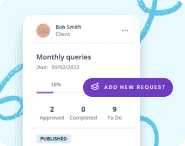Whether you’re a freelancer or a large digital agency, raising your prices is something you’re going to have to deal with at one time or another.
You might send clients a price increase letter, an email, or just tell them in person. Either way, you’ll want to give some thought to the words you use to explain and justify your increases.
In this post, we’ll discuss what to say and provide a sample price increase letter template.
But before we get into that, we’ll first explore the background behind raising your prices.
Just starting out? Now is the time to future-proof your pricing

If you’re at the start of your new lifestyle you’re probably experiencing the buzz, excitement, and slight panic of working for yourself. That could mean you rarely think further ahead than next week because you just want to get clients on board first.
However, it’s good to take a little time out and think about your service price strategy for the first 12 months and beyond.
Does that feel a little presumptuous?
If you feel that way it’s perfectly natural, but many freelancers – myself included – later reach a point where they wish they’d given more thought to their pricing strategy at the very start.
| Pro tip: Use a calculator to set your ratesSetting your rates can be a daunting task, especially if you're just starting out. However, there are tools available to simplify this process. One of them is the Freelance Rate Calculator that helps you quickly determine your hourly, daily, or per-project rates. |
Reasons to increase prices
Unless you can be sure that none of your bills and expenses will be going up in the next year, you need some sort of rate increase just to stand still. Other factors that might influence your decision to increase prices are as follows:
- Better quality of your services
- Growing demand
- Expansion of your services
- Client segmentation
- Market trends
- Customized solutions
What’s more, if you invest in your skills through training, reading industry blogs or going to conferences, you’ll probably be getting better at what you do all the time. That means your clients are getting more value from you, so if you don’t increase your prices at some point, you’re probably selling yourself short.
Price increase notice: How to communicate the change

So now let’s assume you’re ready to raise your prices and you want to know how best to inform your customers. Before we look at a specific letter template, let’s explore some dos and don’ts.
1. Get to the point
Let’s face it, this letter or email is all about one thing – a price increase. It’s best to just get to the point quickly – tell them how much their prices will be going up by, what they will be afterwards and when this all takes effect.
You’re increasing prices, and that’s totally fine.
If they want to read the whole letter and find out more, they will and they don’t want to have to get in touch with you because the price change wasn’t clear.
If you waste too much time on fluff and preamble, your client will see right through it. As they read it they’ll be thinking “Come on, what’s the bad news?” so they’ll be grateful to you for getting to the point and sharing that price increase announcement right away.
2. Don’t be apologetic
You have every right to raise prices once in a while. Don’t forget that probably every bill you have to pay will go up on a regular basis. Keep your letter factual and resist the temptation to sound apologetic.
3. Use the passive voice
Copywriters will often talk about using either the active or passive voice in copy and content. The active voice can be used to explain what you will do, for example “I will prepare a quote for you and email it to you by the end of the day”.
The passive voice is subtly different and gives the impression that something will just routinely happen, rather than as a result of any special effort on your part, for example: “A quote will be prepared and emailed to you by the end of the day”.
The active voice implies decisive action on your part and is great for delivering good news. The passive voice however can be better for news that might be perceived as bad, so it could work much better for price increase letters.
So rather than saying “We will be increasing our prices….” you could simply say “Our prices will be increasing…”.
4. Don’t create a reason for the relationship to end
If your insurance premium goes up at renewal time, then there’s a good chance you will shop around for a better deal. Industries like insurance know that every renewal brings the risk of losing a customer.
However, as a creative – even if you do offer annual contracts or ongoing retainers – you aren’t necessarily ruled by renewal or review dates like other industries are. It’s important that you don’t create the perception in your customers’ minds that the price increase is a reason for them to shop around.
You should also avoid creating too prominent a “call to action” in your letter or email. It’s enough to simply ask them to contact you if you have any queries, then you can deal with any questions in the appropriate way.
5. Remind them what they get from you already
No matter what you do, there may still be a few clients that do choose to look around for a cheaper service. If that should happen, you don’t just want them benchmarking you against your competitors on price alone.
Remind them of the value you offer them, month in month out. This might be as simple as a bulleted list of the services provided under a retainer, or for key clients you might want to tailor the letter to include specific results or metrics you’ve achieved for them.
You could also mention higher operating costs or other important elements leading to a new pricing policy.
For long standing clients, it’s also good to remind them that you’ve built up many years’ knowledge of their business and can provide what they want quickly and easily. If you’re doing your job well, replacing you with a cheaper competitor could backfire on them.
It could take months or years before they know your customer’s business well enough to provide the quality of service that you do.
6. Be flexible (but only for the right clients)
Think about the likely reactions from your clients. If the increases aren’t well received, there may be some you’d be happy to work with to agree to a more modest increase or extend your existing pricing for a longer period.
Equally, there may be others that you’re happy to see go if they don’t see the value you provide in return for your fees. It’s vital that you have a strategy in mind for each client, should they take the opportunity to question your pricing.
Price increase letter template

So here’s my suggested template for communicating price increases to your clients. As you’ll see, once the above thoughts have been taken into account there really isn’t the need for a long, rambling letter. What you don’t say is just as important as what you do say.
Subject: Price Changes – April 20XX
Dear __________
I’m writing to let you know that our prices will be increasing by 3% with effect from 1st April. For you, this will mean an increase from $800pcm to $824pcm starting with your April invoice.
As you know, we value your business and have enjoyed working with you and achieved some great results along the way. Like any business though, our own operating costs do increase over time.
To maintain the level of service you’re accustomed to, this modest increase is necessary, so we wanted to communicate this to you in good time. We’re confident that our prices remain competitive within our sector for the quality of the service that we provide and as always, we’re focused on the results we provide to clients.
I’d like to remind you of the service we provide to you on a monthly basis, which includes:
- Service 1
- Service 2
- Service 3
Thanks again for your business, and please contact me if you have any questions about your new prices.
Yours Sincerely
Note: Not all customers are created equal — tailor your letter
This simple template should give you a good starting point for communicating your new prices to customers. Remember though, you should adapt the tone and wording to suit both your organization and the client in question.
You should even go as far as asking yourself whether a letter or email is the right approach for certain clients. For larger clients, you may prefer to raise the subject face-to-face in a meeting first, and simply follow up by email or letter as a courtesy.
Different prices for different channels
There are many ways to find work when you start out. Some work well in the short-term to get you established, whereas others provide good quality work and relationships that you’ll want to build for the future. Each route to market has its own pricing implications.
You’ve probably heard people dismiss the likes of Upwork and Fiverr because they involve offering cheap work to people with tiny budgets. That criticism is warranted, but do you know what’s great about these sites?
You can build a portfolio and a reputation and then just drop them. Then you’ll have a portfolio and you’ll be ready for better work at better rates.
Now let’s imagine you’re a freelancer and you start working with a local marketing agency. Let’s say you do SEO on their clients’ websites because they don’t have any in-house SEO expertise.
This is a match made in heaven, right?
You really want to work with them so you set your rates very keenly, but fast-forward a few months and they’ve fed you lots more work and you’ve taken it on at the same rate. You’re now much better at what you do and should be charging more but you don’t want to rock the boat so you don’t ask for an increase.
Long story short, if a route to market is one you want to develop over time, price is on the high side, unless you’re happy to work on those rates for a very long time. If you price it too low at the start, it isn’t fair to them if you need to hike your prices by 20% a year later.
If you need to prove yourself, cheap busy market places offer a great opportunity for you to over-deliver and build a great reputation, which you can then take with you into better-paid opportunities.
If you're working with clients remotely or across different time zones, you might consider starting a conference call to discuss your pricing strategy and any potential increases. This can help you address any concerns or questions they may have and ensure that everyone is on the same page moving forward.
An alternative to raising your prices
Despite everything we’ve said above, for some people there is a way to avoid raising your prices – greater efficiency.
If you can create greater efficiency by systemising your processes and workflow and maybe creating SOPs (Standard Operating Procedures) you could save a lot of time on projects as you get more proficient.
Let’s say you build websites and typically earn about $5,000 per project. If you can reduce the time you spend on building each site by 20% you can take on more projects at the same rate and earn more.
As long as you actually find more work, that’s effectively the same as a 20% increase on your rates.
However, eventually you might hit a ‘wall’ where you just can’t improve your efficiency any further. I’d also still consider reviewing your prices anyway, because quite frankly if you’re diligent enough to make such efficiencies, you deserve to reap the financial rewards of it.
Another thing you can do is to streamline processes like document collection. For most businesses we have surveyed, collecting content and files from clients accounts for the most time wasted in their business.
That's because they're using email, which is a productivity killer.
Fortunately, there is an alternative.
Our platform, Content Snare, makes requesting information from clients a breeze. Thanks to its intuitive dashboard and other advanced features, Content Snare helps you collect info in record time.
Related: How this digital marketing agency saves 50 hours each month using Content Snare
Here are some of the best functions:
- Dozens of ready-made templates for designers, accountants, law firms, etc.
- Auto-save lets respondents pick up where they left off
- Pre-filling enables you to insert data that you already know
- Automated reminders save time — you don’t need to send them manually
More importantly, you can check all of these features by signing up for our 14-day free trial.




Heya,
For a country like mine, Malaysia, we are full of cheapskates. As the years go by, clients actually ask us to give THEM a discount. And no matter how much we tell the client about the successes we've shared, they will pick on the very, very few times that we stumbled. So should we still try to defend our price increase or leave it with them to stew for a while? And if they still argue, should we call it a day with them?
With one of my clients, in the end, I decided that we should part ways because, after that discussion, the client started being very curt with us like a jilted ex trying to teach us a lesson in "respecting our client." Once they started being hostile towards my staff, I pulled the plug.
Oh well...
Google for you!
While it may be difficult to lose the initial revenue, it will also allow you the chance to potentially earn more with a new client.
It’s not always about the money… sometimes you have to do what’s best for you and your associates. The difference between a troublesome client and a good client is night and day.
Once you find a client who respects and pays you fairly you will never look back and start to become more selective who you choose to work with.
Best Wishes
I would always defend it, unless your prices really are ridiculously high. But from you've said it sounds like that's not the case
Thank you for helping with it. I was struggling to find the right words to say.
Hi, thanks for the article. My case is a little different. I undercharged for the job I was assigned, I was not totally aware of the complexity and the length of the job. We’ve already agreed on the price before the details of the job was sent yo me. I’m done with the job now and I spent more time than I first thought. I believe this was clearly an error from my side. How do you think I should approach this please?
The proper answer is that scope changes need to be agreed to in writing, before you actually do them.
I would be upfront with your client, own the fact that you should have told them earlier, and see how they take it. Perhaps you could negotiate a lower rate for the extra hours. I would probably do this on the phone so it doesn't feel so impersonal.
Ultimately I would be prepared to end up with them only paying for the agreed amount and chalk it up as a learning experience.